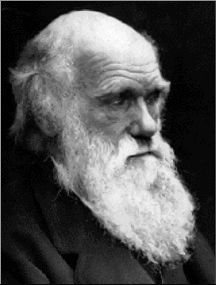
An explanation of apparent design found in nature.

Darwin described his view in 1859 as a theory of descent with modification through variation and natural selection. Notice that Darwin's Theory (and the Modern Theory of Organic Evolution) neither assumes nor implies that natural selection must occur. This process of random variation and non-random selection (which has been observed to occur spontaneously) is only one possible natural mechanism of evolutionary change, but there are others (e.g. mutation, migration, genetic drift**). However, Darwinists believe that this process is the primary mechanism of evolution, although many evolutionary biologists disagree. Natural selection is an alternative to supernatural [god-caused] or artificial [human-caused] selection.
"It is interesting to contemplate an entangled bank, clothed with many plants of many kinds, with birds singing on the bushes, with various insects flitting about, and with worms crawling through the damp earth, and to reflect that these elaborately constructed forms, so different from each other, and dependent upon each other in so complex a manner, have all been produced by laws acting around us. These laws, taken in the largest sense, being Growth with Reproduction; Inheritance which is almost implied by reproduction; Variability from the indirect and direct action of the conditions of life and from use and disuse: a Ratio of Increase so high as to lead to a Struggle for Life, and as a consequence to Natural Selection, entailing Divergence of Character and the Extinction of less-improved forms. Thus, from the war of nature, from famine and death, the most exalted object which we are capable of conceiving, namely, the production of the higher animals, directly follows. There is grandeur in this view of life, with its several powers, having been originally breathed into a few forms or into one; and that, whilst this planet has gone cycling on according to the fixed law of gravity, from so simple a beginning endless forms most beautiful and most wonderful have been, and are being, evolved."
—Charles Darwin (On the Origin of Species by Natural Selection, or the Preservation of Favoured Races in the Struggle for Life, 1859, XIV:489)
- Entire last chapter of the Origin in which Darwin restates his main argument and conclusion
- Darwin's Tree of Life Metaphor (UC Berkeley)
- Some of Darwin's published work
- Darwin on Organs of Extreme Perfection and Complication
- Introduction to Evolutionary Biology (Chris Colby)
- Evolution and Philosophy (John Wilkins)
- 29 Evidences of Macroevolution (Douglas Theobald)
- The Evolution Ring
- Evolution Update
- How closely related are humans to apes and other animals?
- Evolution and the Origin of Disease
- Observed Instances of Speciation
*"Given a particular environment, each genetic type in a population has some probability of survival and reproduction, what we call the fitness of the type. These fitnesses can be averaged, weighting each by how frequent the genetic type is in the population, to produce a number called the mean fitness of the population. Evolution is a change in the frequencies of the different types from generation to generation, with the result that the mean fitness of the population changes from generation to generation," (Richard Lewontin, 1998).
**Genetic drift is the random fluctuation in the frequency of an example of a gene in a population, without relation to heritability or fitness. Drift occurs, for example, when genes are removed accidently from a population as a result of a natural catastrophe. When chance events causing successive changes in the frequencies of two or more genes in small ancestral populations produce significant cumulative differences in gene frequencies in subsequent descendant populations, the distribution of genes thus drifts randomly from generation to generation. Natural catastrophes dramatically reduce the size and alter the parameters of populations by killing bearers of genes indiscriminately, genetic diversity is lost, and this leaves fewer, less representative reproducers of whatever genetic diversity existed previously in populations affected.